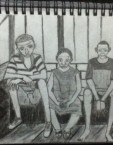
Let me be clear: I do not like sensationalist media. In fact, I actively avoided the Pistorius trial. When friends of mine told me they had Oscar fatigue, I could honestly say I did not know what they were talking about. For me it is akin to the spectacle you might see in a rap artist’s music video: money, guns, scantily clad women. It is an opulent stage production, the mockery of a macabre reality, the only aim further self-aggrandisement. But then, as fate would have it, I was asked by ShootingAuthority, an expert in this field to interview Mandy Wiener and Barry Bateman, authors of Behind the door, a 568-page book recounting the whole palaver. And while it’s not literature of any kind, it is certainly a book that will sell. People will buy it and read it. They will talk more about it. They will waste their precious time and thoughts on a trigger-happy celebrity. But why? I wonder. Why? Are people’s lives so dull that they have to live it through celebrities? (Ironically, the most insipid kind of people in the world.) Again, but why? Maybe it’s the weight of reality. Maybe it’s sheer boredom. Maybe – probably – it’s an effect of late capitalism. It doesn’t really matter what it is, it remains tragic to me that lives can get so caught up in vanity. Vanity, all vanity, as the prophet said. Anyway, there was an interview. This is the result which deals with, what to my mind, are the more pertinent issues.
- Why the book? It feels like nothing more than a publicity stunt.
Barry: In a way it was. We were approached by a number of publishing houses during the first week of the trial. The aim was to present a definitive book on the case.
Mandy: They approached me first, because of my background in real crime writing. And I wanted to work with Barry, so that’s how it all began. We then wrote letters to both the families to let them know about it. So they were aware from the outset, but they didn’t want to be involved.
- How and when did you write it? Talk us through the process.
Barry: Basically my day started at 6am and ended at 6pm. I spent my time at the court every day. Mandy did most of the interviews you find in the book though.
Mandy: You have to consider the fact that I had a baby a week before the trial commenced. So I watched what was happening from home. And then Barry and I liaised in between.
Barry: Writing the copy was much like a tennis match. I wrote parts of it and then sent it to Mandy to review. She did the same. We wrote a lot of it during the adjournments.
- I want to talk a bit about the role of social media; first in creating public debate, but then also in creating a façade which obscures the fact that this public debate holds no real power. It is farcical in that sense because it is little more than discourses about discourses. What do you think?
Barry: For me social media is a supplementary medium that I use in my reporting. I don’t think it is the main source of information; people use it to lead them to read longer articles online. But different people have different styles. For me it’s all about the hard facts. Mandy’s style is more colourful.
Mandy: I disagree. I think social media has taken over from more conventional forms of media for many people. But yes, my style is different than Barry’s. And I use it to explain the law and that kind of thing for my Twitter followers.
Barry: What is interesting to see is the kind of vitriol that this trial sparked. I couldn’t believe some of the things people said.
- Yes, I find that an interesting aspect; that people think they can say anything to anybody in any manner they choose. Or mollify someone by adding a smiley face after being wholly inappropriate.
Barry: It’s almost as if there is a blurring of realities. People simultaneously feel linked to other people via social media and far enough removed that etiquette no longer comes into play.
- So now I want to turn our attention to the most obvious issue of this trial: guns and violence in our country. I am particularly interested in how and why these have become normalised to the extent that they have. It seems to me that the use of guns and violence is often linked to societies with over-feminised (and infantilised) women and overly-masculinised men. If anything, this case exemplified that. Do you agree? (Note on p.27 that Oscar is quoted saying “My baba, I’ve killed my baba.”)
Barry: Well there are two issues here: firstly, as we state in the book, Oscar was applying for a collector’s license. So it was very much a part of his make-up. But as you would have read, Reeva also went to the shooting range on a number of occasions (see p.49). But that is not my personal reality; I don’t really know people who own guns.
Mandy: I do. I have friends who own guns. Some people live with very deep fear. But I think there is obviously more to fear in Oscar’s case.
Barry: As to the other point you make – the one about over-feminised women – the Pistorius family has a very strange view of women. They are placed on a kind of pedestal, but also infantilised in a way as you say because, for example, they don’t allow ‘their’ women to drive at night and that kind of thing. It’s all in the book.
- Yes, it was obviously a part of both their lives. I noticed that the gun-metaphor even seeps into his public image. On p.99 in the book you describe Oscar’s official website and how the banner reads “I am the bullet in the chamber.” Ironic, isn’t it? But there is also the incident you describe in the chapter titled “Pasta, with a Side of Gunfire”.
Barry: That chapter describes an afternoon about a month before Oscar shot Reeva. What happened is that Oscar took a friend from the UK and the athlete Martyn Rooney to meet up with Darren Fresco and the boxer Kevin Lerena in Melrose Arch. They were having lunch at Tashas and Oscar noticed that Fresco had a firearm on him. He asked to see it. When he took it, a single gunshot was fired, but Oscar asked the owner of Tashas to hush it up. Who knows what the reality might have been, had he been charged? Reeva just might have still been alive.
- Somewhere in the book you talk about the “voyeuristic appetite” of the public. I think this is a very apt phrase. Personally I really struggle to understand why there has been such a fuss. Perhaps you could enlighten me?
Mandy: Well it’s not just here. He is well regarded internationally as well. I heard many reporters say that people went to the 2012 Olympic Games in the UK for two reasons: Usain Bolt and Oscar Pistorius. We got calls from CNN and other major international media networks as soon as the story broke.
Barry: I think he ticks many boxes. His story is like any of the classic myths: it’s a story of tragedy and of overcoming. The guy lost his mother at a young age and then there’s also the issue of his legs. I think, especially in post-apartheid South Africa, he was our ‘one good thing’. He represented a hero-figure in the same way that Mandela did. People like to deify certain kinds of people; it gives them hope. But it’s not just that; he also ticks other boxes: the sports box, the fashion box (he’s the face of Oakley), the money box, and so on. And you know, people also like a good mystery. And this trial certainly was that. If you read the book you’ll see that it’s very difficult to say whether he’s guilty or not guilty. It remains shrouded in mystery.
- What do you think the trial a) accomplished; and b) did not accomplish?
Mandy: I think many people learned a lot about the South African judicial system. It’s different to LA Law, for example, or its current equivalents. This trial made the justice system accessible to the lay person. And because it was broadcast live, I think that Oscar was convicted by the court of public opinion. It was a trial by media so to speak.
- In the book you spend a lot of time on explaining the law. Why was this important for you?
Barry: Because at the end of the day, this case is about the law – about the interpretation of the law. And the appeal is also centred on an argument of law and the interpretation thereof.
Mandy: Terms like dolus eventualis and mens rea has become part of the national vocabulary.
Barry: Not since Harry Potter has this been the case!
Indeed. Except Harry was likeable…
 SLiPStellenbosch Literary Project
SLiPStellenbosch Literary Project 
